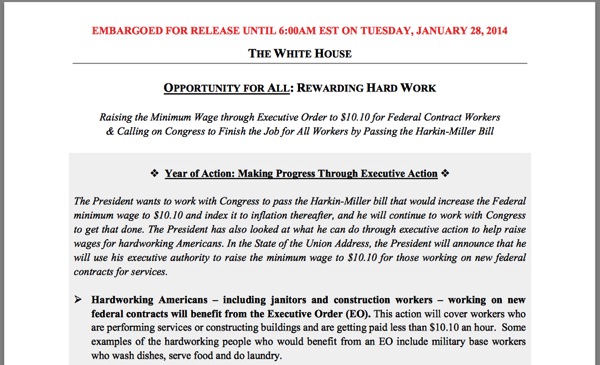Must-Reads:
-
Jonathan Cohn: Obamacare Death Spiral Not Happening: “In the world of Obamacare hate, the law’s failure is imminent and inevitable… an insurance ‘death spiral’…. Could Obamacare enrollment really go so awry? Sure. But some news from Wednesday is one more sign that such a crisis is unlikely…. Wellpoint… officials announced that enrollment in their health plans was meeting expectations… 400,000 new customers already and expected to have close to a million by… the final day of March…. If the pattern holds, Wellpoint won’t be taking the kinds of losses that force higher prices next year.”
-
Simon Wren-Lewis: Understanding ever-increasing executive pay: “Why did executive pay start taking off in the 1980s?… Tax rates on top incomes were… substantially reduced… the CEO has a much greater incentive to put lots of effort into the bargaining process with the company… microeconomic evidence that CEO pay for firm’s performance that is outside the CEO’s control (i.e. that is industry wide, and so does not reflect personal performance) is more important when tax rates are low…. There is a nice parallel between the compensation bargaining model and the union bargaining model popular outside the US in the 1970s/80s, which made many economists somewhat antagonistic to growing union power…”
-
Igor Volsky: 6 Ways Extreme Income Inequality Is Making Your Life Worse: “1979-2007… top 1 percent… families experienced a 278 percent increase… families in the middle 60 percent saw an increase of less than 40 percent…. 1. Income inequality forces Americans into debt…. 2. Income inequality makes America sick…. 3. Income inequality makes America less safe…. 4. Income inequality makes America less democratic…. 5. Income inequality undermines the American dream…. 6. Income inequality is undermining long-term economic growth…”
-
Mark Thoma: Sharing the Gains from Economic Growth: “Reducing inequality a major part of his State of the Union Address…. But to avoid being accused of waging class warfare, he will talk about creating ‘ladders of opportunity’ instead of focusing directly on the inequality problem. This shift in emphasis is a mistake…. Opportunity is unequal, and creating ‘ladders of opportunity’ should be part of any attempt to address the inequality problem. But… the distribution mechanism is broken, the gains from economic growth have not been widely shared… focus solely on opportunity does nothing to solve the problem of income being misdirected to the upper end of the income distribution.”
Continue reading “Things to Read at Lunchtime on Thursday, January 30, 2014”


